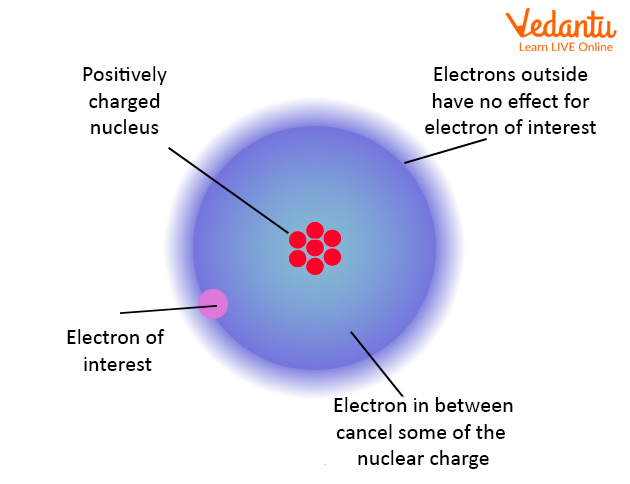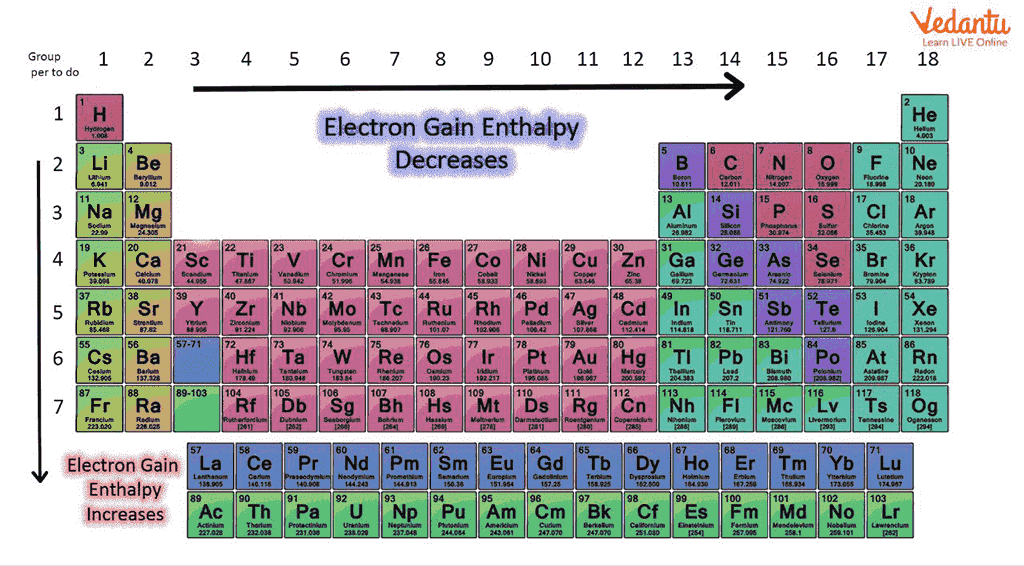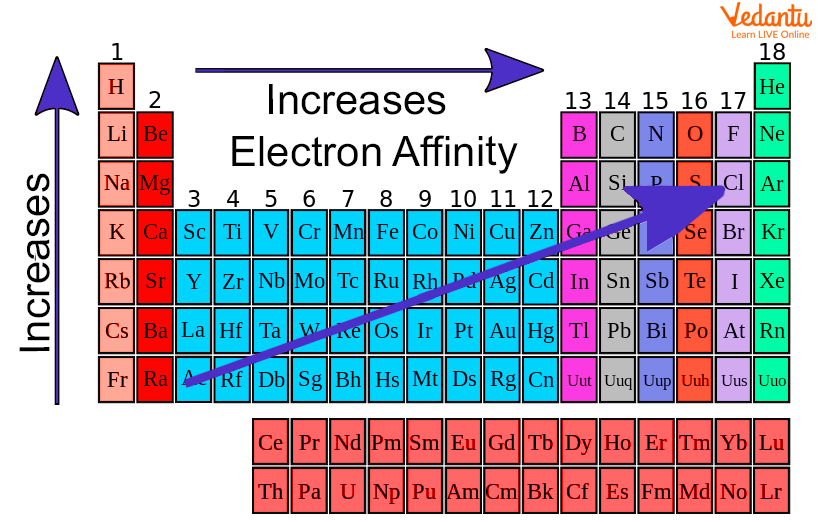




Basic Introduction to Electron Gain Enthalpy and Electron Affinity
The electron gain enthalpy is an indication of the ability of an atom in gaseous state to release its energy when it gains electrons. It is used in many chemical and physical processes, including photosynthesis and combustion. In general, molecules with higher negative electron gain enthalpies are more reactive and can release energy more easily. The value is negative if the energy is released (exothermic) and positive if the energy is absorbed (endothermic). The electron affinity of an atom is the amount of energy released when an electron is added to a gaseous atom.
What is Electron Gain Enthalpy and Types of Electron Gain Enthalpy
In chemistry, electron gain enthalpy is the change in enthalpy that accompanies the addition of an electron to an atom(gaseous state). The Electron Gain Enthalpy (EGA) is a measure of the strength of the attractive force between an atom and an electron.
In general, the negative EGA decreases as the atomic number of the element increases in a group. This trend is due to the increasing size of the atom, which decreases the attractive force between the nucleus and electrons. The electron gain enthalpy is also affected by shielding electrons between the nucleus and electron which we are observing. If the number of shielding electrons increases the effective nuclear charge decreases and negative electron gain enthalpy also decreases.

Electron Gain Enthalpy
Types of Electron Gain Enthalpy
Negative Electron Gain Enthalpy
Positive Electron Gain Enthalpy
1. Negative Electron Gain Enthalpy: Negative electron gain enthalpy indicates negative values when the energy gets released. When halogens gain electrons, it gains stability. Halogens have a highly negative electron gain enthalpy because they show a strong affinity to reach stable noble gas configuration.
2. Positive Electron Gain Enthalpy: In positive electron gain enthalpy, the element is reluctant to accept the other electron. The noble gases place the extra gained electron into the higher energy level as they have a high positive electron gain enthalpy which leads to highly reactive and unstable electronic configuration. It indicates that it has large positive values for noble gases.
Electron Gain Enthalpy in Groups and Periods
As we move from left to right in the periodic table, the elements get increasingly negative electron-gain enthalpy. This trend is due to the increasing atomic number, nuclear charge and reduced size.
The higher the negative ΔegH, the more stable the atom becomes after adding electrons. As we move down a group, the negative ΔegH decreases due to increased size of atoms. The valence shell is getting closer and closer to being filled, so when we reach the end of a group, ΔegH stays almost constant.
The value of electron gain enthalpy(kJ/mol) of many elements is shown below.

Trends of Electron Gain Enthalpy in Periodic Table
Factors Affecting Electron Gain Enthalpy
The factors affecting electron gain enthalpy are
The size of the atom: The smaller the atom, the more tightly bound the electrons are to the nucleus, and thus the more difficult it is for them to be attracted to another electron.
The charge on the nucleus: The more positively charged the nucleus is, the greater its attraction for electrons. The effective nuclear charge can also be reduced by the shielding effect of electrons present in an atom which is gaining electrons.
Electron-Electron repulsion: The coming electron with attractive force of nucleus also experiences the repulsion force of other electrons in the same shell it is getting added to. Due to this repulsion, the negative value of electron gain enthalpy decreases.
Electron Gain Enthalpy of Halogens
The electron gain enthalpy of halogens is the enthalpy change that occurs when an electron is added to a halogen atom in gaseous state. This process is exothermic, meaning that it releases energy. The amount of energy released depends on the particular halogen involved. For example, fluorine has a lower negative electron gain enthalpy than chlorine. This means that it takes less energy to add an electron to a chlorine atom than to a fluorine atom. However, the negative value of electron gain enthalpy for Cl to I decreases as the expected trend. The fluorine atom due to smaller size and high electron-electron repulsion in the valence shell releases less energy than chlorine.
What is Electron Affinity ?
The electron affinity of an atom is the amount of energy released when an electron is added to a gaseous atom.
∆egH = –Ae – 5/2 RT
Here, ∆egH is electron gain enthalpy, Ae is electron affinity, T is the temperature and R is the gas constant.
If energy is released when an electron is added to a gaseous atom, the Ae is taken as positive. If energy has to be supplied to add an electron to an atom, then Ae of the atom is assigned a negative sign.
Electron Affinity in Groups and Periods
The higher the electron affinity, the more energy is released and the more likely it is that an atom will accept an electron.
Electron affinities generally increase from left to right across a period on the periodic table. This trend occurs because atoms become smaller and their nuclei more positively charged as you move from left to right across a period. These two factors combine to make it easier for electrons to be added to atoms on the right side of the periodic table.
The general trend for electron affinity also holds true for most groups on the periodic table. The exception to this rule are the noble gases, which have very low electron affinities because their outermost shells are already full of electrons.
The electron affinity decreases down the group because of increased atomic radius. The upcoming electrons don’t feel much attactraction from the nucleus.

Trends of Electron Affinity in Periodic Table
Factors Affecting Electron Affinity
The nuclear charge: The more positively charged the nucleus is, the greater the attractive force between the nucleus and electrons. As a result, atoms with more positive nuclear charges tend to have higher electron affinities.
The number of valence electrons: Atoms with fewer valence electrons relative to their total number of electrons tend to have higher electron affinities because they can fill their valence shells by adding just one or two electrons.
Electron-electron repulsion: Electrons repel each other, so atoms whose valence electrons are already close together are less likely to gain additional electrons because doing so would increase electrostatic repulsion.
Electron Affinity of Halogens
The electron affinity of a halogen is the energy released when an electron is added to a neutral gaseous atom of the halogen. The higher the electron affinity, the more stable the resulting negative ion will be.
The halogens are located in group 7A of the periodic table, and include fluorine (F), chlorine (Cl), bromine (Br), iodine (I), and astatine (At). All of these elements have high electron affinities. The trend of electron affinity of halogen is same as electron gain enthalpy F<Cl>Br>I.
While all of the halogens have high electron affinities, they do not all react equally when exposed to electrons. Fluorine is much more reactive than chlorine, for example, and will readily combine with other elements to form compounds. Chlorine is less reactive than fluorine but still highly reactive compared to most other elements. Bromine and iodine are even less reactive than chlorine.
Summary
In this article we have learned about the two important concepts i.e, Electron Gain Enthalpy and Electron Affinity. The electron gain enthalpy is a measure of the ability of an atom to release energy when it gains electrons. The electron affinity of an atom is the amount of energy released when an electron is added to a gaseous atom. The sign of electron gain enthalpy and electron affinity is opposite for any element. Later we discussed the trends of electron gain enthalpy and electron affinity in periods and groups, along with trends we also discussed about factors affecting the respective concepts.
FAQs on Electron Gain Enthalpy and Electron Affinity for JEE
1. How is electron gain enthalpy related to electron affinity?
Electron gain enthalpy represents the change in enthalpy when an electron is gained by an gaseous atom, whereas electron affinity represents the energy absorbed by the surrounding when an electron is gained. The electron gain enthalpy is a negative value, while electron affinity is a positive value when energy is released by the atom during addition of electron.
2. What is the difference between electron affinity and electronegativity?
Electron affinity is similar to electron gain enthalpy. When a neutral gaseous electron gains an electron, the energy change is called electron affinity. In covalent compounds, electronegativity gives the measure of tendency of the atom to attract a shared pair of electrons towards it. Their trend in the periodic table is almost the same. In general, electron affinity is the measure of tendency to actually add an electron to the atom, while electronegativity is the tendency to just attract the shared pair of electrons.



































